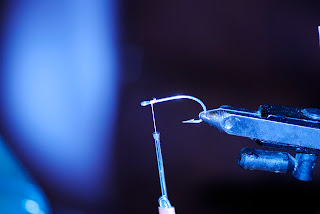I'm a big fan synthetic materials for flies and while epoxy can be a challenge to work with I enjoy using it in many flies. UV resins seem to be preferred by most tyers over epoxy and there are plenty of reasons why. I cannot speak from personal experience with UV resins....yet, but I will get some soon and probably post about a comparison of epoxy to UV resin in another blog.
For now my surf candies are tied with 5min Loctite Epoxy. Any tyers who have worked with epoxy must learn some tricks to using it. My initial surf candies reflect a lack of theses techniques. The result is a still fishable fly, but a lack of the picturesque fly all fly tyers want.
As with all tying that I have trouble with I look for some information in my local club. I had searched online for a while to see if I could find some more information to correct my poorly formed surf candies, but UV resin dominated the videos and blogs. However, at our local tying night I got the secret I was missing from a fellow synthetic matierials fan. I already owned a rotary fly dryer and had been using it, but the missing piece of the puzzle for me was the first layer of epoxy. At the suggestion of my fellow club member, I began using my bodkin to work the first layer of epoxy into the super hair fibers. You need to lift the fibers up from the hook and place the epoxy under and through them. This will probably result in some clumping of the epoxy.

Once the fibers are coated flatten out any clumps of epoxy by running your bodkin along the sides top and bottom. Remeber this is only layer one, the coat should only be enough to hold the fibers into shape. Two big things to remeber: 1)Watchout for the eye of the hook when you apply and smooth epoxy. 2) Epoxy will drip be prepared to deal with it dripping off the hook.
Once the epoxy is evenly distributed, hold the fibers in the position you want them to set in. This can be very tight or splayed out as you prefer, but this is the stage to decide its shape. The form should set in a minute or two. Once it has set, transfer the fly to a rotary dryer or leave it aside to dry. I usually will type several bodies before I mix epoxy then epoxy them all at once.
Once dry, eyes and any other decorations (gills, glitter, etc) can be added. Make sure all these are dry and firmly attached before adding the next layer of epoxy. This layer will make the classic shape of the surf candy. Once the coat is evenly distributed around the fly move it to the dryer and let set.
The final step is to coat the fly in clear nail polish to cover the tacky outside of the epoxy.
Then go fishing.
Fly pattern developed originally by: Bob Popovics







































